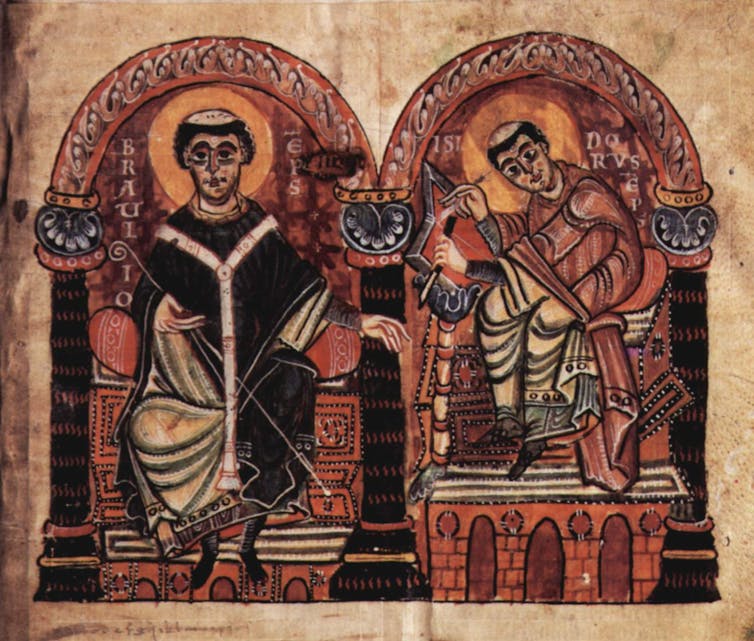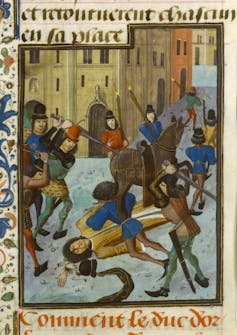
My students tend to imagine the Middle Ages as something like the “Kingdom Come” or “Total War” video games: an age of utter political chaos, when swords and daggers ruled, and masculinity and physical strength mattered more than governance.
As a historian of the Middle Ages, I believe this turbulent image has less to do with reality than with medievalism – a term for how modern people have reimagined life during Europe’s Middle Ages, from roughly 400-1400.
Medieval Europe may have been violent, and its standards for governance would not win praise today. But people could certainly recognize dysfunctional politics, whether in a royal court or in the church, and proposed solutions.
At a time of rising authoritarianism, and when U.S. politics seem mired in chaos, it’s worth looking back at how societies centuries ago defined bad governance.
Tyrants, kings and bad bishops
Authors in the Middle Ages thought about politics in terms of leadership and often called bad politics “tyranny,” whether they were criticizing one leader or a whole system. In any case, tyranny – or autocracy, as it’s often called today – is a concept great thinkers had been discussing since antiquity.
For ancient Greeks, tyranny meant ruling single-handedly for the benefit of one. Aristotle, the foundational thinker on the topic, defined tyranny as the antithesis of perfect rulership, which he believed was kingship: a single ruler ruling for the general interest of all. In his view, a tyrant was controlled by desire for “power, pleasure and wealth,” while a king was driven by honor.
Modern political theorist Roger Boesche observed that tyrants tend to decrease the population’s leisure time. According to Aristotle, free time allowed people to think and “do” politics – that is, to be citizens.
During the Roman Republic, political thinkers compared tyranny to a diseased limb that needed to be cut off the body politic. Ironically, certain Romans eliminated Julius Ceasar for fear he was becoming a tyrant – only to get Augustus, who eventually became an emperor.
Types of despots
In late antiquity, political writers began to think about tyranny in religious leadership, as well.

In his “Sententiae,” a set of books on theology, the seventh century archbishop Isidore of Seville broached the subject of bad bishops. These men conducted themselves like “proud pastors,” he wrote, who “tyrannically oppress the common people, they do not guide them, and they demand of their subjects not the glory of God but their own.” In general, Isidore criticized political incompetence grounded in the leader’s anger, pride, cruelty and greed.
Centuries later, European leaders and writers were still debating the nature of tyranny – and what do to about it.
John of Salisbury, a bishop and philosopher in 12th century England, proposed quite a radical solution: tyrannicide. In “Policraticus,” writings about political theory, he wrote that it was a duty to redress the order of things and kill a tyrant who was evil, violent and oppressive.
In John’s organic conception of tyranny, however, a tyrant (the body) could exist only with the support of society (its limbs). He was one of the earliest authors to argue that tyranny survived not simply by the whim of the tyrant but with the support of his followers.
By the 14th century, the leading legal thinker of the time, Bartolus de Sassoferrato, differentiated between two types of tyranny. Despots came to power through legal means but acted unlawfully. He defined usurpers, on the other hand, as rulers who assumed power illegitimately, wallowed in pride and did not follow the law.
Taking down a tyrant
At times, disliked or “inconvenient” leaders were deposed, such as England’s Richard II. The record of his deposition itemized almost three dozen charges against the dethroned king: from rejecting council, defaulting on loans and exhorting religious authorities to murdering, disinheriting and impeaching rivals. We know that he did not end well: He died during imprisonment in 1400, though exactly how is a mystery.
In Germany, King Wenceslaus of the house of Luxembourg was deposed on Aug. 20, 1400, on grounds of being a “useless, indolent, careless divider and unworthy owner of the empire.” The German newspaper Die Welt ranks him as the worst king of Germany – fond of drink and his hunting dogs, and possessed by fits of rage.

Violent disposals of supposed “tyrants” were not always done in the shadows. In 1407, Louis of Orléans, brother of King Charles VI of France, rode unknowingly into a deadly trap. He was assaulted by a large group of men who escaped and chased onlookers away.
Louis was not only brother to Charles “the Mad,” but a political rival of John the Fearless, Duke of Burgundy, with both men vying for control during the king’s bouts of mental illness. John assumed responsibility for ordering the murder.
He and the lawyer he hired, a theologian named Jean Petit, argued that Burgundy had acted in the interest of the nation by ordering the death of a treasonous and greedy tyrant, and that Louis’ killing was therefore justified.
Men of the cloth
Medieval politics did not differentiate much between the secular and religious worlds. Popes were political leaders and could be considered tyrants, too.
During the Great Western Schism of 1378-1417, a split in the Catholic Church when multiple popes competed for the throne, all parties insulted each other with claims of illegitimacy and usurpation.
Enemies of Pope Urban VI, for example, argued a telltale sign of tyranny was his uncontrollable anger, which disqualified him for leadership. Dietrich of Nieheim, who worked at the papal chancery, noted in his chronicle, “The more he spoke, the more Lord Urban became angry, and his face finally became like a burning lamp or fiery flame from anger, and his throat was filled with hoarseness.” French cardinals deposed Urban in 1378 on grounds of illegitimacy and tyranny.
He was not the only pope unseated for being tyrannical, even if that exact word was not used. The Council of Constance, a council of European clergymen convened to end the schism, deposed Pope John XXIII in 1415 on grounds ranging from disobedience and corruption to poor administration, dishonesty and obstinacy. Two years later, the same council deposed Pope Benedict XIII, accusing him of persecution, disturbing the peace, fostering division, promoting scandal and schism, and unworthiness.
Medieval bishops and kings are hardly role models for democracies today, but their political world was not so chaotic as we often imagine. Even a world ignorant of democracy attempted to define what bad leadership was and set limits on the authority of the ones they considered irresponsible. Rules of adequate political conduct were established, though the law did not always take precedence over violence.
But it’s worthwhile to remember the ways people have viewed bad leadership, hundreds of years before our own era’s fractured politics. Today, however, we have a big advantage: We vote our leaders in and out.![]()
Joelle Rollo-Koster, Professor of Medieval History, University of Rhode Island
This article is republished from The Conversation under a Creative Commons license.


Leave a Reply